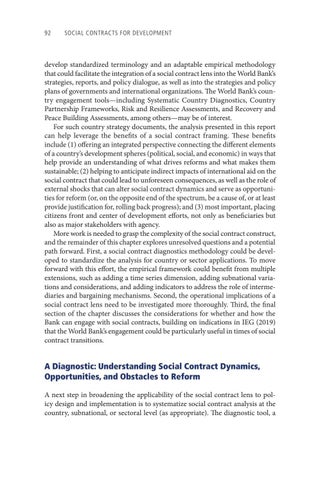92 SOCIAL CONTRACTS FOR DEVELOPMENT
develop standardized terminology and an adaptable empirical methodology that could facilitate the integration of a social contract lens into the World Bank’s strategies, reports, and policy dialogue, as well as into the strategies and policy plans of governments and international organizations. The World Bank’s country engagement tools—including Systematic Country Diagnostics, Country Partnership Frameworks, Risk and Resilience Assessments, and Recovery and Peace Building Assessments, among others—may be of interest. For such country strategy documents, the analysis presented in this report can help leverage the benefits of a social contract framing. These benefits include (1) offering an integrated perspective connecting the different elements of a country’s development spheres (political, social, and economic) in ways that help provide an understanding of what drives reforms and what makes them sustainable; (2) helping to anticipate indirect impacts of international aid on the social contract that could lead to unforeseen consequences, as well as the role of external shocks that can alter social contract dynamics and serve as opportunities for reform (or, on the opposite end of the spectrum, be a cause of, or at least provide justification for, rolling back progress); and (3) most important, placing citizens front and center of development efforts, not only as beneficiaries but also as major stakeholders with agency. More work is needed to grasp the complexity of the social contract construct, and the remainder of this chapter explores unresolved questions and a potential path forward. First, a social contract diagnostics methodology could be developed to standardize the analysis for country or sector applications. To move forward with this effort, the empirical framework could benefit from multiple extensions, such as adding a time series dimension, adding subnational variations and considerations, and adding indicators to address the role of intermediaries and bargaining mechanisms. Second, the operational implications of a social contract lens need to be investigated more thoroughly. Third, the final section of the chapter discusses the considerations for whether and how the Bank can engage with social contracts, building on indications in IEG (2019) that the World Bank’s engagement could be particularly useful in times of social contract transitions.
A Diagnostic: Understanding Social Contract Dynamics, Opportunities, and Obstacles to Reform A next step in broadening the applicability of the social contract lens to policy design and implementation is to systematize social contract analysis at the country, subnational, or sectoral level (as appropriate). The diagnostic tool, a
